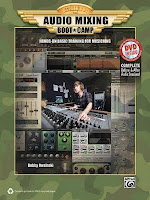 As many of you know, my new Audio Mixing Bootcamp book was recently released. The book is different from The Mixing Engineer's Handbook in that it's aimed at the novice who's just starting to mix, or someone who can't seem to get their arms around the process. It's also completely different from other mixing books in that it's full of concise exercises to get your ears up to speed on what sounds good and what doesn't.
As many of you know, my new Audio Mixing Bootcamp book was recently released. The book is different from The Mixing Engineer's Handbook in that it's aimed at the novice who's just starting to mix, or someone who can't seem to get their arms around the process. It's also completely different from other mixing books in that it's full of concise exercises to get your ears up to speed on what sounds good and what doesn't.Here's an excerpt from Chapter 4: Balance that gives you some tips on how to visualize your mix even before you've moved the first fader. By the way, there's also a video version of the course that can be found at Lynda.com.
---------------------
"Most mixers can hear some version of the final product in their heads before they get too far into the mix. This is because they’ve heard rough mixes of the song many times before during production, but even if a mixer is brought in just for the mix, they listen to all the elements several times before they really get down to mixing.
If you’re just starting out mixing, you might think, “How can I hear the final product before I’ve even begin?” That’s a fair enough question. Until you have a certain amount of experience, you need a few questions to help mold your vision a bit, and the way to do that is to go back to the six mix elements and ask yourself:
How do I hear the final balance?
How do I hear the instruments EQed”
How do I hear everything panned?
How do I hear everything compressed?
How do I hear the ambience in the track?
What do I hear as the most interesting thing in the track?
If you can answer these questions, you may still not have a full picture of your final mix, but you’ll have at least a general idea, which is the first step to a great mix.
Keep in mind that the producer and musicians have a say in the mix as well, and your version of the mix can suddenly take a wide left turn with their input. That’s okay, because after you’ve gotten everything to the point where you hear it in your head (or even beyond), a left turn should be easy.
Exercise Pod: Visualize Your Mix
E4.1: Either listen to a rough mix of the song you’re working on, or quickly just push up all the faders for a rough balance to the song you’re about to mix. Let’s think about the balance.
A) How loud do you hear the drums in the final mix? The bass?
B) Do you hear the vocals out in front, or back in the track?
C) How loud do you hear the primary musical elements that carry the song?
D) How loud do you hear the secondary elements like percussion and background vocals?
E4.2: Now let’s think about the frequency response of the various instruments.
A) Is there an instrument or two that sounds particularly dull?
B) Is there an instrument or two that sounds overly bright?
C) Is there an instrument that has too much bottom end?
D) Is there an instrument that has no bottom end at all?
E4.3: Now let’s think about the panning.
A) How do you hear the drums panned? Wide or narrow?
B) How do you hear the panning of any instruments that were recorded in stereo?
C) Do you hear any instruments panned extreme wide left and right?
D) What instruments do you hear panned up the middle?
E4.4: Now let’s go to compression.
A) Is there an instrument or vocal that has wild dynamic shifts that needs compression?
B) Is there an instrument or vocal that you’d like to change the sound by using compression?
C) Is there an instrument or vocal that needs to sound a little more punchy?
E4.5: Let’s think about the ambience.
A) What instruments were recorded with room ambience or reverb?
B) Do you hear ambience on the drums or snare?
C) What instruments do you hear rather dry and in your face?
D) What instruments do you hear further away from you?
E4.6: Lastly, it’s time to think about the interest.
A) What’s the most important element in the mix?
B) If there isn’t one yet, how can I create one?
C) What’s the next most important element in the mix?
D) What’s the next most important element in the mix?
These aren’t all the questions that you can ask yourself about a mix, but you get the idea. Remember, there are no right or wrong answers. It’s as you visualize it in your head."
To read additional excerpts from The Audio Mixing Bootcamp or my other books, go to the excerpt section at bobbyowsinski.com.
----------------------------------
You should follow me on Twitter for daily news and updates on production and the music business.
Don't forget to check out my Music 3.0 blog for tips and tricks on navigating social media and the new music business.


No comments:
Post a Comment